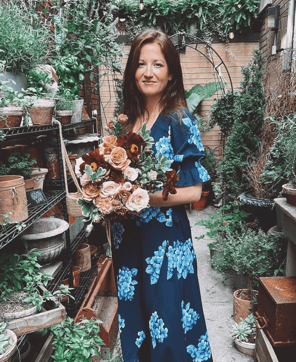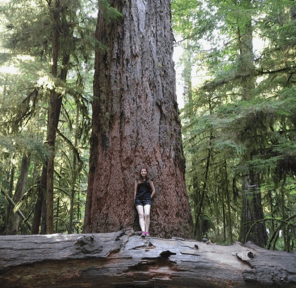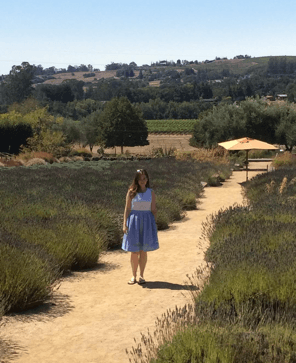We caught up with the brilliant and insightful Kate Dunn-Flynn a few weeks ago and have shared our conversation below.
Alright, Kate thanks for taking the time to share your stories and insights with us today. It’s always helpful to hear about times when someone’s had to take a risk – how did they think through the decision, why did they take the risk, and what ended up happening. We’d love to hear about a risk you’ve taken.
My career path has been nothing short of vibrant! From teaching assistant and professor to special events coordinator, research interviewer and document controller at two large Canadian EPCM companies, my journey could be described as a giant kaleidoscope of diverse experiences, opportunities, and plenty of risks. Some risks have worked out and others have rerouted me in directions I may not have thought to pursue. These redirections have ended up leading me down paths that have allowed me to grow and develop in ways I could never have anticipated had I not taken those risks myself.
The biggest risk I have ever taken was as a contract employee in the world of post-secondary education. I knew at the time that contractual work was precarious, and that job security would be a constant gamble from semester to semester, but my love for teaching and the opportunity to educate others was a risk I felt was worth taking. Since childhood, I have always loved the role of education in teaching, motivating, inspiring, and empowering each of us to reach our full potential and create positive, substantive change in the world. I remember lining up my toys (students) in rows in front of my green Fisher-Price chalkboard and the thrill of teaching them. I can’t recall what expertise I imparted to them at the ripe age of 3, but I reveled in the idea of helping them learn more about the world around them.
This love of education continued from childhood throughout my teens and propelled me towards pursuing an Honours Bachelor of Arts Degree in Sociology, quickly followed by a Master’s degree in the same subject. I would have been content to remain a full-time student, but after my first teaching assistantship at the age of 19 I knew I wanted to pursue a career in education, specifically at the post-secondary level.
My childhood dream of being an educator soon materialized when I had the opportunity to teach an introductory sociology course, which I jumped at without hesitation.
I remember my first semester as a whirlwind of excitement and hard work. I poured my heart and soul into creating engaging lesson plans, attending professional development events to develop and hone my teaching skills, and connecting with my students in the classroom. The experience was enriching and the feedback I received from my Chair and my students after my first semester teaching was overwhelmingly positive; I knew I had found my calling.
But as that first semester ended, reality set in. As a contract employee, there was no guarantee that I would be asked back for another semester. The precarious nature of contractual teaching never cast doubt in my mind that I loved this field, but rather whether I was willing to take the risk that it would actualize into full-time employment.
Despite the uncertainty, I decided to take the risk and continued pursuing my passion for education. The next few years were a rollercoaster of highs and lows. There were moments of triumph, when my students would have breakthroughs and excel in their work. But there were also moments of doubt, when I wondered if the instability of my employment was worth its pursuit. Despite this, I persevered. I continued to teach with passion and dedication, despite the lack of job security, and dove headfirst into the world of academia. I accepted additional contracts, eventually teaching close to 40 courses, developing 5 new courses, and taking close to 300 professional development workshops. I also wrote book reviews for the London School of Economics and Political Science, and published journal articles. Over the years I built a reputation as a dedicated educator, engaged employee/colleague, and curriculum developer.
Eventually, my commitment to teaching paid off in a big way when I was offered a full-time appointment as a professor. It was a dream come true; a validation of all the risks I had taken and the sacrifices I had made in pursuit of my love of teaching.
Looking back on my journey as a contract employee in the world of post-secondary education, I know that the risks I took were worth it. The uncertainty and instability were daunting at times, but they were a small price to pay for the opportunity to do what I love every day.

Kate, before we move on to more of these sorts of questions, can you take some time to bring our readers up to speed on you and what you do?
Before starting out as an educator, I recognized as a student myself early on that not all my peers had the same opportunities to thrive academically as I did. Access to mentors or tutors, the support from parental and familial figures, a safe environment to complete homework, a supportive friend group, and a teacher that believed in them was not necessarily the rule for many, it was the exception. My school friends and fellow peers came from all walks of life; some came from affluent families where post-secondary was a given and others experienced poverty where post-secondary was considered a distant dream. It was this realization that further ignited a passion in me to become an educator and advocate for those who may be marginalized or underrepresented in education. My goal then, as it is today, was to help bridge the gaps in education that can perpetuate inequality. While I teach a wide range of courses focused on social inequality, EDI principles, positive psychology, and gender, I believe that education encompasses more than books and classrooms; it also involves nurturing holistic growth to ensure individuals feel seen, valued, and supported. I strive to do this by recognizing and valuing my students as individuals with emotions and subjective lived experiences. This approach entails understanding and considering their background, identities, strengths, challenges, and unique academic needs. I believe this has helped me build authentic connections, create a supportive and inclusive learning environment, and foster a sense of belonging. If we focus on the humanity within our classrooms, I believe as educators we will have more engaged learners, see increased empathy, and witness heightened academic success.
One of my favourite quotes, and one that I aspire to live by every day in my role as an educator, was written by William Arthur Ward: “The mediocre teacher tells. The good teacher explains. The superior teacher demonstrates. The great teacher inspires.” It reminds me that while it is important to be an effective educator, imparting information, explaining it in detail, and demonstrating how it can be applied, my higher purpose is to inspire students to learn and achieve more on their own. I try to do this by encouraging creativity and independent thinking in the classroom, providing opportunities for students to share their own ideas and perspectives respectfully, and celebrating my students’ achievements and progress. My goal is to encourage them to be lifelong learners, while also instilling a sense of curiosity for the world around them, and helping them find the motivation to reach their full potential.
My love for nature and personal wellness also plays a role in my personal teaching toolbox, as I prioritize implementing wellness strategies in my classes to promote the overall well-being and success of my students. I incorporate mindfulness and relaxation techniques, such as deep breathing exercises and guided meditation, to help students manage stress, improve focus, and maintain a healthy school-life balance. I aim to foster a supportive, positive learning environment that prioritizes wellness and the space for students to advocate for themselves and communicate if they need additional support. In doing so, I aim to empower students to lead healthy and fulfilling lives both inside and outside of the classroom.
I have had many proud moments teaching in post-secondary over the years, including seeing my students walk across the stage at graduation, reach out to me and let me know they continued with grad school, or send me an email letting me know how much they are thriving in their chosen profession. This is the greatest gift a student can give their teacher.
I am incredibly proud of my role as an advocate for students. For over five years, I have been part of a program that offers free post-secondary and employment-pathways courses to community members. This has been an incredibly rewarding and fulfilling experience, as I have had the chance to see firsthand the positive changes that my students make in their own academic journeys, their personal lives, and in their communities. Being able to positively impact the lives of students who may not have the same opportunities as others has brought me immense satisfaction and continues to play a role in my life as I strive for equity and inclusion in education.
I am also a proud Board Member of the Eva Rothwell Center, a community Centre and hub that empowers individuals to cultivate essential life skills and maximize their potential in their academic and professional lives. It is a great honour to be a part of a Centre that helps our community members find their calling and ignite a passion in them.
A more recent proud moment of mine was co-developing a minor in disability studies. The minor aims to empower students to better understand and advocate for individuals with disabilities, and foster a more inclusive, compassionate and equitable society through allyship. While a more recent addition, we have already heard from students that they are seeing themselves reflected in the curriculum for the first time and, for others, they have communicated that it is an opportunity to confront their own biases and assumptions about disability for the first time.

We often hear about learning lessons – but just as important is unlearning lessons. Have you ever had to unlearn a lesson?
A lesson I have had to unlearn is the idea that failure is a negative outcome. I used to feel I needed to have all the answers and never make any mistakes to be a successful professor. However, I now realize that failure is an opportunity to identify areas I need to improve upon and is an essential part of learning and growing. Instead of thinking, “What if it doesn’t work out?” I try to reframe this instead as, “What if it all worked out?” Dr. Carol Dweck’s concepts of growth mindset and “Not Yet” have also been immensely helpful in reminding me that failure is a temporary setback, rather than a permanent defeat. While I may not always succeed in my initial attempt at something, I remind myself I just haven’t reached my goal “yet”. This mindset provides me with hope, motivation, and a sense of resilience in the face of challenges. In embracing failure, I also aim to teach my students that mistakes are stepping stones towards future success. By creating a culture that normalizes failure as part of the learning process, I hope to instill in my students the resilience and confidence needed to overcome setbacks, learn and grow from their mistakes, and continue to strive for success in all aspects of their academic and personal lives.

Can you tell us about a time you’ve had to pivot?
I had to pivot early on in my teaching journey. During my very first week of teaching, I went into my class thinking the best way to teach a concept was to present it in a standardized format with the expectation that all students would master it at the same time. However, I quickly realized that each student had their own unique learning style, strengths, background knowledge, and pace of learning. Some students excelled with hands-on activities, while others preferred visual aids or auditory explanations. By recognizing and embracing these differences, I was able to pivot and adapt my teaching methods to better meet the individual needs of my students and embrace more personalized and differentiated instructional strategies and pedagogical methods. This meant offering multiple ways for students to learn and demonstrate their understanding, providing extra support or challenges as needed, and allowing for flexibility in pacing. As a result, I saw a significant improvement in student engagement, comprehension, and overall academic performance. It also created a more inclusive and effective learning environment in my classes. It was a humbling realization, but I am grateful it happened early in my teaching career. It was a learning opportunity for me that ultimately made me a more effective and empathetic educator.
Contact Info:
- Instagram: rooted_in_wellness_co
- Linkedin: https://www.linkedin.com/in/kate-dunn-flynn-29094a50/

Image Credits
Headshot: Hannah Kiviranta


